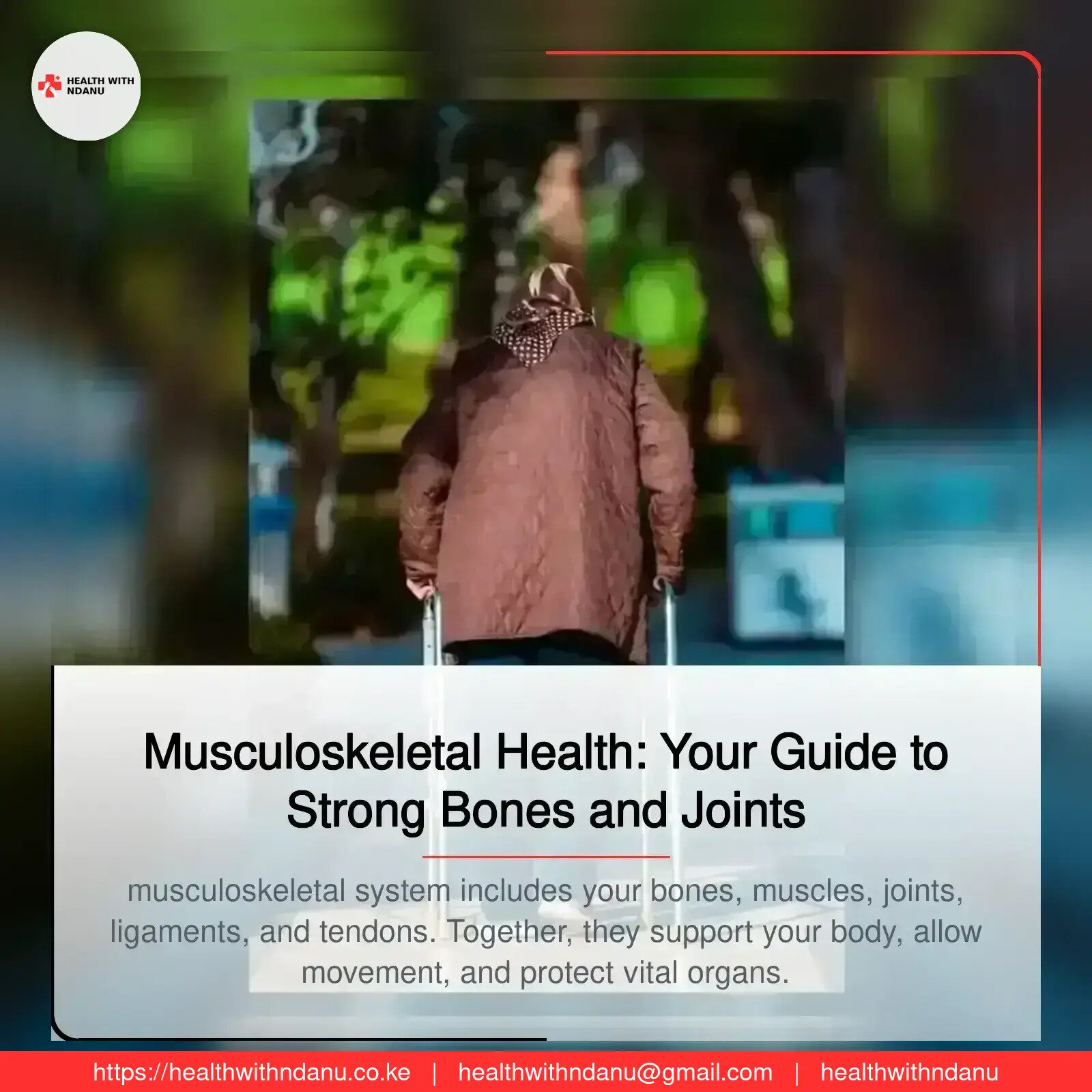Musculoskeletal Health: Your Guide to Strong Bones and Joints
- by Diana Ndanu
- 29 December, 2024
- 0 Comments
- 5 Mins



Introduction
Musculoskeletal health is something we often take for granted—until something goes wrong. Whether it's a sore back after sitting too long or aching knees from climbing stairs, our bones, muscles, and joints play a crucial role in keeping us active and pain-free.
In this guide, we’ll explore what musculoskeletal health is, why it’s important, common issues, and practical tips to keep your body strong and mobile. Let’s dive in!
What is Musculoskeletal Health?
Your musculoskeletal system includes your bones, muscles, joints, ligaments, and tendons. Together, they support your body, allow movement, and protect vital organs.
Think of it like the framework of a building: if one part weakens, the entire structure can be compromised. That’s why taking care of your musculoskeletal system is essential for maintaining an active and independent lifestyle.
Why Musculoskeletal Health Matters
A healthy musculoskeletal system isn’t just about avoiding injuries—it’s about improving your overall quality of life. Here’s why it’s important:
1. Mobility and Independence: Strong muscles and flexible joints make it easier to perform daily tasks and enjoy physical activities.
2. Injury Prevention: Healthy bones and muscles reduce the risk of fractures, sprains, and strains.
3. Pain Management: Maintaining good musculoskeletal health helps prevent or alleviate chronic pain conditions like arthritis or back pain.
4. Long-Term Wellness: Strong bones reduce the risk of osteoporosis as you age, and regular movement supports heart and mental health.
Common Musculoskeletal Issues
Here are some common problems you might encounter:
1. Back Pain
- Often caused by poor posture, heavy lifting, or prolonged sitting.
- Can range from mild discomfort to debilitating pain.
2. Arthritis
- A condition that causes inflammation in the joints, leading to pain and stiffness.
- Osteoarthritis and rheumatoid arthritis are the most common types.
3. Osteoporosis
- Weakening of the bones, making them more prone to fractures.
- Common in older adults, especially women post-menopause.
4. Tendonitis
- Inflammation of tendons, often due to overuse or repetitive movements.
- Common in areas like the shoulders, elbows, and knees.
5. Muscle Strains and Sprains
- Can occur from overexertion or improper movement.
- Symptoms include swelling, bruising, and reduced mobility.
How to Keep Your Musculoskeletal System Healthy
The good news? There are plenty of simple steps you can take to protect and strengthen your musculoskeletal health.
1. Exercise Regularly
- Weight-Bearing Exercises: Activities like walking, jogging, and dancing help build bone density.
- Strength Training: Builds muscle mass to support your bones and joints.
- Flexibility and Balance Exercises: Yoga and stretching improve joint mobility and reduce the risk of falls.
2. Eat for Strong Bones and Muscles
- Calcium-Rich Foods: Dairy products, leafy greens, and fortified foods.
- Vitamin D: Helps your body absorb calcium; get it from sunlight, fish, and supplements.
- Protein: Found in lean meats, beans, and nuts to repair and build muscles.
3. Maintain Good Posture
- Sit and stand with your back straight and shoulders relaxed.
- Use ergonomic furniture to reduce strain during work or leisure.
4. Stay Active
- Avoid long periods of sitting. Take breaks to stretch or walk.
- Incorporate physical activity into your routine, even if it’s just a short walk.
5. Protect Your Joints
- Avoid repetitive movements that strain your joints.
- Use proper techniques when lifting heavy objects.
6. Don’t Ignore Pain
- Listen to your body. Pain is a signal that something might be wrong.
- Seek medical advice if discomfort persists.
Therapies and Treatments for Musculoskeletal Issues
If you’re dealing with a musculoskeletal condition, there are plenty of treatment options available:
1. Physical Therapy
- Aims to improve strength, flexibility, and mobility through targeted exercises.
- Often used to recover from injuries or surgeries.
2. Chiropractic Care
Focuses on spinal alignment to reduce pain and improve function.
3. Medication
Pain relievers, anti-inflammatories, or supplements like calcium and vitamin D.
4. Surgical Options
Reserved for severe cases, such as joint replacements or fracture repairs.
5. Alternative Therapies
Acupuncture, massage therapy, and herbal remedies may provide relief for some people.
When to See a Doctor
It’s important to seek professional help if you experience:
- Persistent pain that doesn’t improve with rest.
- Swelling, redness, or heat around a joint.
- Difficulty moving a limb or joint.
- Frequent falls or balance issues.
Closing Thoughts
Your musculoskeletal health is the foundation of your physical well-being. By staying active, eating well, and taking care of your body, you can enjoy a life full of movement and vitality.
Remember, small changes add up over time. Start by incorporating a few healthy habits into your routine today, and you’ll thank yourself later.
Have any tips or experiences to share about musculoskeletal health? Let’s keep the conversation going in the comments below!
Got Your Own Experience? Share with us
Popular Categories
Most Visited Blogs
Daily Newsletter
Get all the top stories from Blogs to keep track.



